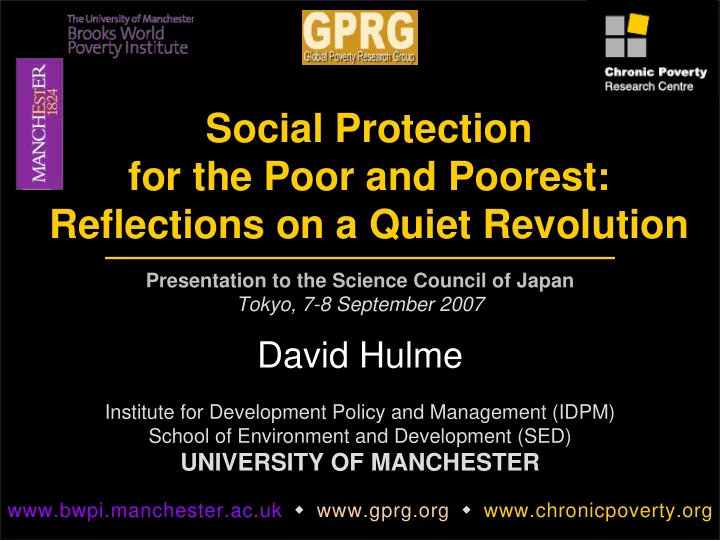

Social Protection for the Poor and Poorest: Reflections on a Quiet Revolution Presentation to the Science Council of Japan Tokyo, 7-8 September 2007 David Hulme Institute for Development Policy and Management (IDPM) School of Environment and Development (SED) UNIVERSITY OF MANCHESTER www.bwpi.manchester.ac.uk � www.gprg.org � www.chronicpoverty.org
Social protection: the quiet revolution • Emerging consensus that social protection is an essential component of national development strategy – along with economic growth and human capital development • Shift from concept of temporary social safety nets, to meeting basic needs and raising capabilities • Massive expansion of coverage – more than 100 million households, half a billion people • Quiet revolution – national policies, incremental, pilot programmes, gradual conceptual shifts
What is social protection? • ‘Public actions taken in response to levels of vulnerability, risk, and deprivation which are deemed unacceptable within a given polity or society’ (Conway, de Haan and Norton 2000) • Food aid, old age pensions, disability grants, sick pay, child grants, cash transfers • Until recently a rich world idea • ILO has been a leading proponent
Three main forms 1. Social insurance – provides protection against lifecourse and work-related contingencies (old age, maternity, sickness, unemployment). Financed by workers and employers. 2. Social assistance – provides support to those in poverty. Tax-financed and also by charities and NGOs. 3. Labour and employment standards – ensures basic standards at work, and extends rights to organisation and voice. Costs met by business and consumers.
Social protection: conceptual underpinnings • Social Risk Management – World Bank, ‘managing income risks’. Short-term social safety nets. • Basic needs – National governments and bilateral donors, meeting minimum levels for income, nutrition, health and education services, shelter, water and sanitation. • Human rights – ILO, ‘entitlements that society provides to individuals and households…to protect against low living standards arising out of…basic risks and needs’. From policy option to state obligation. • Last 10 years – Gradual shift from social risk to basic needs and perhaps human rights thinking.
The rise of social protection in development policy Massive increase in scale last 10 years: • South Africa, Child Support Grant - 7.2m • China, Minimum Living Standards Scheme (MLSS) – 22.4m • Mexico, Oportunidades/Progresa – 5m • Brazil, Bolsa Familia/Escola – 11m • Indonesia, Safety Net Scheme – 15m • India, National Rural Employment Guarantee Scheme (NREGS) – 26m target for 2008 • Malawi, Kenya, Zambia, Uganda and others
Why this Rise? (1) • Failure of structural adjustment and social funds • Rising global insecurity and vulnerability – globalisation promotes rapid economic transformation (former Soviet Union, China) • Economic and financial crises – 1997 • HIV/AIDS pandemic • Violent conflict – sub-Saharan Africa, Afghanistan, Iraq • Climate change
Why this Rise? (2) • The costs of not having social protection – Human suffering – Slower economic growth/reduced productivity – Reduced agricultural production – Reduced human capital (health, nutrition, education) – Higher mortality • Millennium Development Goals and the process surrounding them
Evolution of Social Protection (1) • Latin America has been a leader and innovator – Progresa/Oportunidades (Mexico), Bolsa Escola/Familia (Brazil), Chile Solidario. Conditional cash transfers (CCTs) of cash + child development. Now capability enhancement strategy in Chile. • South Asia is experimenting. Old age pensions across the region, ultra-poor programmes in Bangladesh. Now major initiatives of NREGS and Unorganised Sector Worker’s Social Security Bill (USWSS) in India.
Evolution of Social Protection (2) • South East and East Asia – responding to 1997 financial crisis and transformation in China. Very important for rural population in China. • Sub-Saharan Africa – a ‘Southern Africa’ model is emerging (old age pensions and child support grants financed by tax). Elsewhere donor experiments with cash transfers and CCTs. • Globally - More often social assistance rather than social insurance (reverse of European evolution).
Roles of External Actors (1) • ILO historically the lead, but has been challenged by growth of informality and decline of trade unions. ‘Decent work’ has become its focus. • World Bank has become a major player since late 1990s. Internal debate/war about whether social risk management or basic needs approach. • IMF ’s role remains constraining social expenditure – little sign of understanding the economic costs of not having social protection.
Role of External Actors (2) • Other UN family – various positions but they lack the coherence/intellectual credibility of other actors • Bilaterals – DFID and GTZ very active in Africa. USAID taking an interest. What’s JICA/Japan doing? • NGOs – very important for humanitarian work, but less so longer term social protection (except HelpAge International and Save the Children Foundation)
Embedding Social Protection – Key Issues • Scale, scope and integration in national plans • Programme design, client selection and implementation • Financing – can they afford it, versus the costs of not having social protection • The politics of social protection – building coalitions to support social protection
Conclusions (1) • Evidence growing that social protection reduces vulnerability, improves welfare of the poor, raises socio-economic mobility and supports economic growth. • Quiet revolution is underway – integrated strategies of economic growth, human capital development and social protection. • Impacts, at a basic material level – reducing the suffering of the world’s poorest people. • Impacts, in terms of ideas – helping to shift national and international debates from safety nets and charity to citizenship and solidarity
Conclusions (2) • Analyses based on self-interest (how can I make the world a good place for my children?) also recognising social protection – national social cohesion and international security • But two major knowledge frontiers for researchers to focus on: 1. Scaling up programmes – raising implementation capacities and stopping donors from making them a development fad 2. Social protection models for fragile states/ regions and difficult environments
Recommend
More recommend